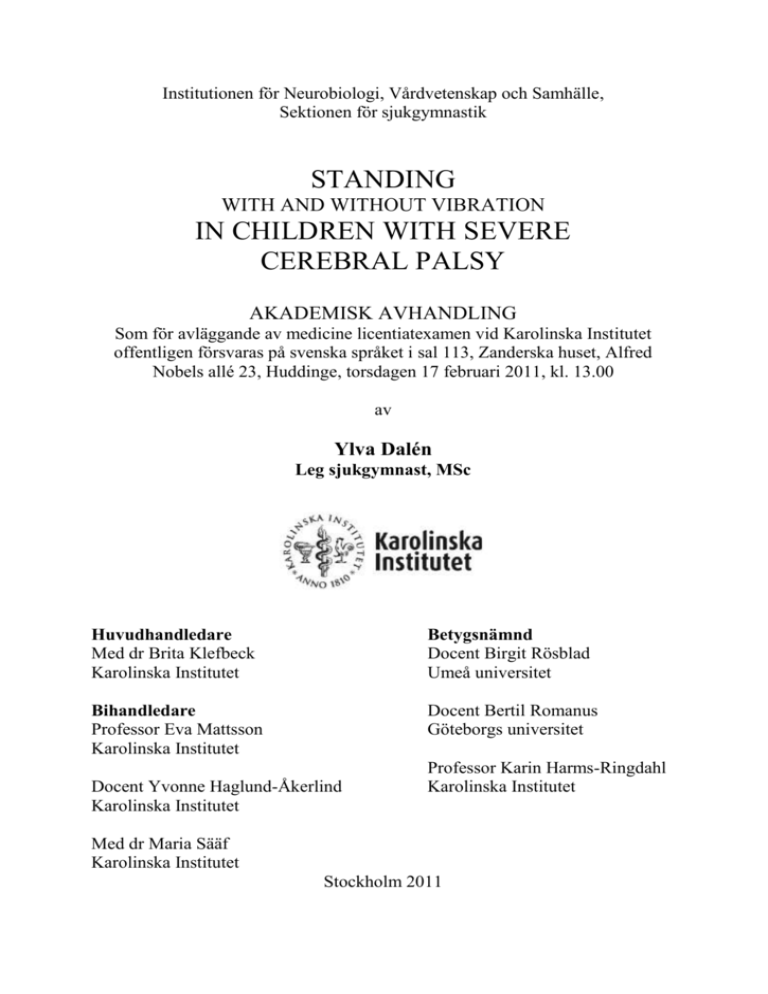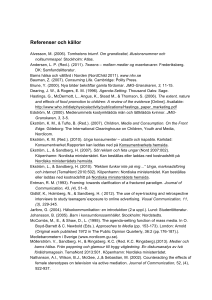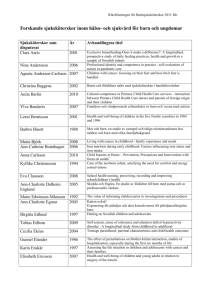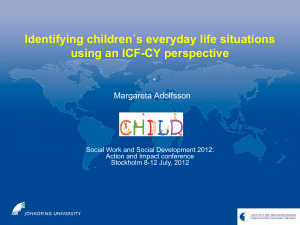Institutionen för Neurobiologi, Vårdvetenskap och Samhälle
advertisement

Institutionen för Neurobiologi, Vårdvetenskap och Samhälle, Sektionen för sjukgymnastik STANDING WITH AND WITHOUT VIBRATION IN CHILDREN WITH SEVERE CEREBRAL PALSY AKADEMISK AVHANDLING Som för avläggande av medicine licentiatexamen vid Karolinska Institutet offentligen försvaras på svenska språket i sal 113, Zanderska huset, Alfred Nobels allé 23, Huddinge, torsdagen 17 februari 2011, kl. 13.00 av Ylva Dalén Leg sjukgymnast, MSc Huvudhandledare Med dr Brita Klefbeck Karolinska Institutet Betygsnämnd Docent Birgit Rösblad Umeå universitet Bihandledare Professor Eva Mattsson Karolinska Institutet Docent Bertil Romanus Göteborgs universitet Docent Yvonne Haglund-Åkerlind Karolinska Institutet Professor Karin Harms-Ringdahl Karolinska Institutet Med dr Maria Sääf Karolinska Institutet Stockholm 2011 ABSTRACT Children with severe cerebral palsy (CP) risk fragile bones, fractures and hip dislocation due to disuse. A standing shell allows these children weight bearing in an upright position. Recommended standing time is one to two hours/day but evaluations are lacking. The aim of Study I was to assess the effects of time spent in the standing shell on bone mineral density (BMD) and hip dislocation. A cross-sectional design was used. Eighteen children with severe CP median age 10.5 years, modified Ashworth score (MAS) 0-1 (n=7) and 2-4 (n=11) participated. The standing shell was used a median of 40 (4-164) min/day. DEXA measurements of BMD in the lumbar spine were 73% of age-matched children. X-ray of the hips showed a migration index of 27 (0-52) % in the most dislocated hip. Standing time was not associated with BMD but in the eleven children with spasticity standing time was significantly and negatively associated with hip dislocation. The aim of Study II was to evaluate the effects of a unique platform using whole body vibration (WBV) on bone mineral content (BMC), to note the reactions of the children and to record any negative side-effects. A modified cross-over experimental design was used. Four boys with severe CP, median age 4 years, Insulin-like growth factor-I standard deviation score (IGF-I SDS) median -0.42µg/L, participated. Two boys used the platform for 8/9 months and two were controls (period I). After one year of no use, users and controls exchanged roles (period II). The boys in period I were exposed to vibration a median of 2.5 (range 1-6) occasions/month with a median of 12.5 (3-23) min/occasion. IGF-I SDS differed from baseline to end of period I in children exposed to vibration 1.8/1.0 in contrast to not exposed -0.1/0.9 µg/L. BMC in one leg differed 8.9/-4.3 and -3.2/-5.1g, respectively. The boys in period II were exposed a median of 6.5 (range 1-12) occasions/month 10 (6-10) min/occasion. IGF-I SDS differed from baseline to end of period II in children exposed to vibration -0.7/1.6 in contrast to not exposed -1.0/-0.2 µg/L. BMC in one leg differed 13.7/16.3 and 9.9/3.9g, respectively. No negative side-effects were recorded. Conclusion: Time spent in the standing shell alone may not influence bone mineral density in children with severe cerebral palsy and may even have a negative effect on hip dislocation in children with spasticity. Standing in the standing shell on a platform with whole body vibration may be an effective and enjoyable method to increase bone mineral content in children with severe cerebral palsy. ISBN 978-91-7457-141-7




